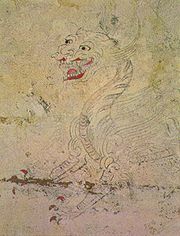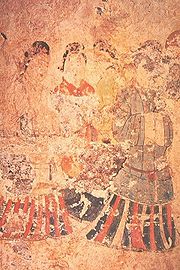
Takamatsuzuka Tomb
Encyclopedia


Japanese language
is a language spoken by over 130 million people in Japan and in Japanese emigrant communities. It is a member of the Japonic language family, which has a number of proposed relationships with other languages, none of which has gained wide acceptance among historical linguists .Japanese is an...
is an ancient circular tomb
Tomb
A tomb is a repository for the remains of the dead. It is generally any structurally enclosed interment space or burial chamber, of varying sizes...
in Asuka village
Asuka, Nara
is a village located in Takaichi District, Nara, Japan.As of September 1, 2007, the village has an estimated population of 6,146 and a density of 255.23 persons per km². The total area is 24.08 km².Asuka is the land where ancient palaces were located...
, Nara prefecture
Nara Prefecture
is a prefecture in the Kansai region on Honshū Island, Japan. The capital is the city of Nara.-History:The present-day Nara Prefecture was created in 1887, making it independent of Osaka Prefecture....
, Japan
Japan
Japan is an island nation in East Asia. Located in the Pacific Ocean, it lies to the east of the Sea of Japan, China, North Korea, South Korea and Russia, stretching from the Sea of Okhotsk in the north to the East China Sea and Taiwan in the south...
.
The tomb is thought to have been built at some time between the end of the 7th century and the beginning of the 8th century. It was accidentally discovered by a local farmer in the 1960s.
The mound of the tomb was built of alternating layers of clay
Clay
Clay is a general term including many combinations of one or more clay minerals with traces of metal oxides and organic matter. Geologic clay deposits are mostly composed of phyllosilicate minerals containing variable amounts of water trapped in the mineral structure.- Formation :Clay minerals...
and sand
Sand
Sand is a naturally occurring granular material composed of finely divided rock and mineral particles.The composition of sand is highly variable, depending on the local rock sources and conditions, but the most common constituent of sand in inland continental settings and non-tropical coastal...
. It is about 16 meters in diameter and 5 meters high. Digging yielded a burial chamber with painted fresco
Fresco
Fresco is any of several related mural painting types, executed on plaster on walls or ceilings. The word fresco comes from the Greek word affresca which derives from the Latin word for "fresh". Frescoes first developed in the ancient world and continued to be popular through the Renaissance...
wall paintings of courtier
Courtier
A courtier is a person who is often in attendance at the court of a king or other royal personage. Historically the court was the centre of government as well as the residence of the monarch, and social and political life were often completely mixed together...
s in Goguryeo
Goguryeo
Goguryeo or Koguryŏ was an ancient Korean kingdom located in present day northern and central parts of the Korean Peninsula, southern Manchuria, and southern Russian Maritime province....
-style garb. The paintings are in full color with red, blue, gold, and silver foil representing four male followers and four abigails together with the Azure Dragon
Azure Dragon (Chinese constellation)
The Azure Dragon is one of the Four Symbols of the Chinese constellations. It represents the east and the spring season. It should not be confused with the mythological yellow dragon that is associated with the Emperor of China...
, Black Tortoise
Black Tortoise (Chinese constellation)
The Black Tortoise is one of the Four Symbols of the Chinese constellations. It is sometimes called the Black Warrior of the North , and is known as Xuanwu in Chinese, Genbu in Japanese, Hyeonmu in Korean and Huyền Vũ in Vietnamese. It represents the north and the winter season...
, White Tiger
White Tiger (Chinese constellation)
The White Tiger is one of the Four Symbols of the Chinese constellations. It is sometimes called the White Tiger of the West , and is known as Baihu in Chinese, Byakko in Japanese, Baekho in Korean and Bạch Hổ in Vietnamese...
, and Vermilion Bird
Vermilion Bird (Chinese constellation)
The Vermilion bird is one of the Four Symbols of the Chinese constellations. According to Wu Xing, the Taoist five-elemental system, it represents the fire-element, the direction south, and the season summer correspondingly. Thus it is sometimes called the Vermilion bird of the South...
groups of stars. The paintings are designated as a national treasure of Japan
National treasures of Japan
National Treasures are the most precious of Japan's Tangible Cultural Properties, as determined and designated by the Agency for Cultural Affairs...
.
For whom the tomb was built is unknown, but the decorations suggest it is for a member of the Japanese royal family or a high-ranking nobleman. Candidates include:
- Prince OsakabePrince OsakabePrince Osakabe was a Japanese imperial prince who helped write the Taihō Code, alongside Fujiwara no Fuhito...
(? - 705), a son of Emperor TemmuEmperor Temmuwas the 40th emperor of Japan, according to the traditional order of succession.Temmu's reign lasted from 672 until his death in 686.-Traditional narrative:... - Prince YugePrince YugePrince Yuge was a Japanese prince. He was the son of Emperor Temmu and Princess Ōe, daughter of Emperor Tenji. His full brother was Prince Naga. He is notable as one of the candidates for the Takamatsuzuka Tomb....
(? - 699), also a son of Emperor Temmu - Prince TakechiPrince Takechiwas a member of the royal family in Japan during the Asuka Period. He was the eldest son of Emperor Tenmu. He fought on the side of his father in the Jinshin War , a battle of succession, which resulted in his father becoming Emperor...
(654? - 696), also a son of Emperor Temmu, general of Jinshin WarJinshin WarThe was a succession dispute in Japan which broke out in 672 following the death of Emperor Tenji. The name refers to the jinshin or ninth year of the sixty-year Jikkan Jūnishi calendrical cycle, corresponding to the Western year 673....
, Daijō Daijin - Isonokami Ason Maro (640 - 717), a descendant of Mononobe clanMononobe clanThe was a Japanese clan of the Kofun period, known for its military opposition to the Soga clan. The Mononobe were opposed to the spread of Buddhism, not on religious grounds, but more so as the result of feelings of conservatism and a degree of xenophobia...
and in charge of Fujiwara-kyoFujiwara-kyowas the Imperial capital of Japan for sixteen years, between 694 and 710. It was located in Yamato Province , having been moved from nearby Asuka. However, in the Nihon Shoki, the name Fujiwara-kyō had never been used...
after the capital was moved to Heijo-kyoHeijo Palace' in Nara, was the Imperial Palace of Japan , during most of the Nara period. The Palace was located in the north end of the capital city, Heijō-kyō... - Kudara no Konikishi ZenkoKudara no KonikishiThe Kudara no Konikishi was a Japanese clan whose founder Zenkō was a son of the last king of Baekje, King Uija.Kudara was an uji or clan name that represented their country of origin...
(617-700), a son of the last king of BaekjeBaekjeBaekje or Paekche was a kingdom located in southwest Korea. It was one of the Three Kingdoms of Korea, together with Goguryeo and Silla....
, one of the Three Kingdoms of KoreaThree Kingdoms of KoreaThe Three Kingdoms of Korea refer to the ancient Korean kingdoms of Goguryeo, Baekje and Silla, which dominated the Korean peninsula and parts of Manchuria for much of the 1st millennium...
.
http://www.asukanet.gr.jp/asukahome/ASUKA2/TAKAMATUTUKA/takamatutuka.htmlhttp://www.nara-np.co.jp/special/takamatu/vol_02d_01.html
The Cultural Affairs Agency of Japan is considering taking apart the stone chamber and reassembling it elsewhere to prevent further deterioration to its wall paintings. A painting called Asuka Bijin, or "beautiful women", is one of the mural
Mural
A mural is any piece of artwork painted or applied directly on a wall, ceiling or other large permanent surface. A particularly distinguishing characteristic of mural painting is that the architectural elements of the given space are harmoniously incorporated into the picture.-History:Murals of...
s in the tomb facing deterioration. The unusual preservation method is being considered because the tomb's current situation makes it impossible to prevent further damage and stop the spread of mold
Mold
Molds are fungi that grow in the form of multicellular filaments called hyphae. Molds are not considered to be microbes but microscopic fungi that grow as single cells called yeasts...
.
Unlike the Kitora Tomb
Kitora Tomb
The is an ancient tumulus located in the village of Asuka, Nara Prefecture, Japan. The tomb is believed to have been constructed some time between the 7th and early 8th centuries, but was only discovered in 1983....
, also in Asuka, removing pieces of the Takamatsuzuka wall plaster
Plaster
Plaster is a building material used for coating walls and ceilings. Plaster starts as a dry powder similar to mortar or cement and like those materials it is mixed with water to form a paste which liberates heat and then hardens. Unlike mortar and cement, plaster remains quite soft after setting,...
and reinforcing them for conservation appears difficult because the plaster has numerous tiny cracks.
See also
- History of JapanHistory of JapanThe history of Japan encompasses the history of the islands of Japan and the Japanese people, spanning the ancient history of the region to the modern history of Japan as a nation state. Following the last ice age, around 12,000 BC, the rich ecosystem of the Japanese Archipelago fostered human...
- List of National Treasures of Japan (paintings)
- List of Special Places of Scenic Beauty, Special Historic Sites and Special Natural Monuments

